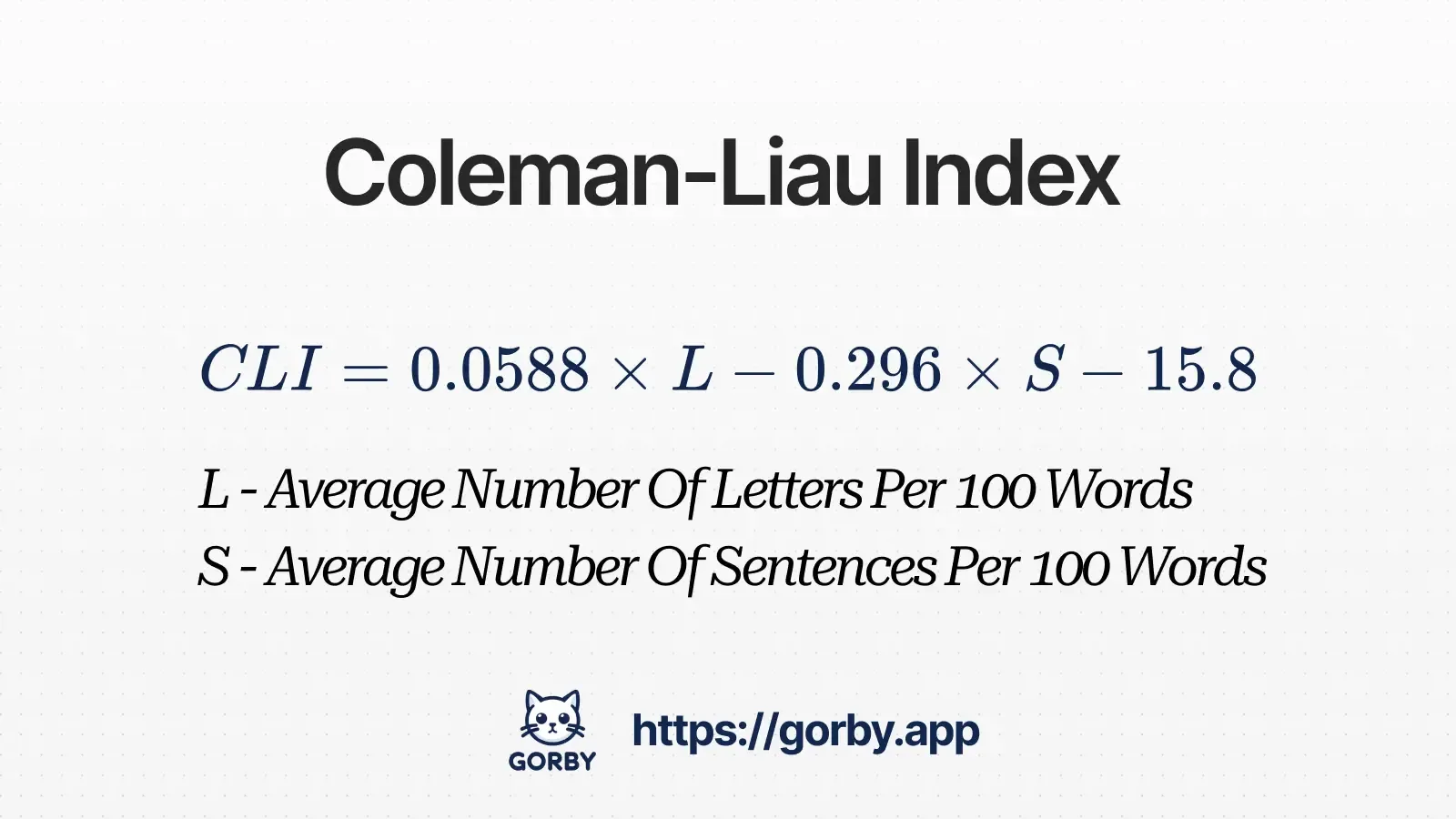Coleman-Liau Index Calculator
Analyze your text's readability using the Coleman-Liau Index (CLI). This precise readability formula helps you understand your content's complexity by analyzing character and sentence patterns, providing accurate grade-level assessments for your writing.
Understanding the Coleman-Liau Index
What is the Coleman-Liau Index?
The Coleman-Liau Index (CLI) is a readability formula developed in 1975 by Meri Coleman and T. L. Liau to evaluate the grade level required to comprehend a text. Working with the U.S. Office of Education, they created this index to help assess the readability of textbooks in the public school system.
Unlike many other readability metrics, the Coleman-Liau Index bases its analysis on characters rather than syllables, examining the relationship between character count and sentence structure to determine text complexity.
Development and Research
Coleman and Liau's research was based on a study of 36 passages, carefully calibrated using a technique called cloze testing. Each passage received 2,400 responses, with 16 scores per word, creating a remarkably precise scale of reading difficulty. This thorough approach led to a formula that achieved a correlation of 0.92 with actual reading comprehension scores.
Their research demonstrated that word length measured in characters was as reliable a predictor of readability as syllable count. This insight led to a simpler yet equally effective approach to readability assessment.
Key Features
The Coleman-Liau Index evaluates text using two primary measurements:
- The average number of letters per 100 words
- The average number of sentences per 100 words
These measurements combine to provide a score that corresponds to the U.S. grade level required to understand the text. For instance, a score of 10 indicates that the text is suitable for a tenth-grade reading level.
Modern Applications
Today, the Coleman-Liau Index is widely used in education, healthcare communication, and content development. Its character-based approach makes it particularly consistent across different types of content, from academic papers to public health materials. The index helps writers and editors ensure their content matches their intended audience's reading level, making information more accessible and effective.
The Coleman-Liau Formula Explained

(Letters ÷ Words) × 100
(Sentences ÷ Words) × 100
Understanding the Components
The Coleman-Liau formula combines two key text measurements to determine reading difficulty. Each component plays a specific role in assessing text complexity:
Letters per 100 Words (L)
The first component (0.0588 × L) measures word complexity through character count. Calculate this by counting the total number of letters in your text, dividing by the total number of words, and multiplying by 100. Longer words typically indicate more complex vocabulary.
Sentences per 100 Words (S)
The second component (-0.296 × S) evaluates sentence complexity. Calculate this by counting the total number of sentences, dividing by the total number of words, and multiplying by 100. This measures average sentence length, with longer sentences generally indicating more complex writing.
Adjustment Constant
The subtraction of 15.8 calibrates the raw score to align with U.S. grade levels. This constant was determined through extensive research comparing text complexity with actual reading comprehension data.
Quick Example
Let's analyze this sample text about the importance of forests:
- Letters: 611
- Words: 128
- Sentences: 9
- L = (611 ÷ 128) × 100 ≈ 477.34
- S = (9 ÷ 128) × 100 ≈ 7.03
- CLI = (0.0588 × 477.34) - (0.296 × 7.03) - 15.8 ≈ 10.19
This passage scores at approximately a tenth-grade reading level.
CLI Grade Level Scale
The Coleman-Liau Index directly corresponds to the U.S. education grade level required to comprehend the text, with the score matching the grade level needed for comfortable reading.
| CLI Score | Grade Level | Reader Age |
|---|---|---|
| 14+ | College (2nd year+) | 19+ |
| 13 | College Freshman | 18-19 |
| 12 | 12th Grade | 17-18 |
| 11 | 11th Grade | 16-17 |
| 10 | 10th Grade | 15-16 |
| 9 | 9th Grade | 14-15 |
| 8 | 8th Grade | 13-14 |
| 7 | 7th Grade | 12-13 |
| 6 | 6th Grade | 11-12 |
| 5 | 5th Grade | 10-11 |
| 4 | 4th Grade | 9-10 |
| 3 | 3rd Grade | 8-9 |
| 2 | 2nd Grade | 7-8 |
| 1 | 1st Grade | 6-7 |
| 0 | Kindergarten | 5-6 |
Interpreting CLI Scores
The ideal Coleman-Liau score depends entirely on your target audience. While lower scores generally indicate better readability, some content requires higher complexity. Here's what you should know:
General Audience Content
Aim for scores between 7-8 (7th-8th grade level). This range is accessible to most readers while maintaining professional credibility.
Technical Documentation
Scores between 11-13 are acceptable, reflecting the complex nature of technical subjects while still maintaining clarity.
Academic Writing
Scores of 14+ are common and often necessary, reflecting the sophisticated concepts and vocabulary required for college-level content.
Public Communications
Aim for scores between 6-7 (6th-7th grade level) to ensure your message reaches the widest possible audience without seeming oversimplified.
📝 Pro Tip
When in doubt, remember that the average adult in the United States reads at approximately an 8th-grade level (CLI score of 8). Unless your content specifically requires higher complexity, aiming for this level ensures maximum accessibility while maintaining professional standards.
Coleman-Liau Index vs other readability metrics
While several readability formulas exist, each offers unique advantages for specific use cases. Here's how the Coleman-Liau Index compares to other popular readability metrics:
Automated Readability Index
Like Coleman-Liau, ARI uses character count instead of syllables. Both formulas provide similar results, with slightly different weighting factors. The main difference lies in their constants and adjustment factors, which were calibrated using different research methodologies.
Flesch Kincaid Grade Level
Flesch-Kincaid uses syllable counts rather than character counts, making it more complex to calculate automatically. While it can provide nuanced analysis of word complexity through syllable counting, research shows character-based measures can be equally effective predictors of readability.
Gunning Fog Index
The Gunning Fog Index considers "complex words" (words with three or more syllables) in its calculations. While this can provide insight into vocabulary complexity, Coleman-Liau achieves similar results by analyzing overall character counts, which naturally correlate with word complexity.
SMOG Index
SMOG focuses on polysyllabic words and requires a minimum of 30 sentences for accurate analysis. Coleman-Liau can provide reliable results with shorter texts and doesn't require complex syllable counting, making it more versatile for various content types.
Key Advantages of Coleman-Liau
- Consistent results across different types of content
- Simple character-based calculations that remain highly accurate
- No minimum text length requirement
- Reliable automated processing
Choosing the Right Formula
While Coleman-Liau excels in many situations, consider using multiple readability metrics for important content. Each formula offers unique insights, and using them together can provide a more complete picture of your text's accessibility.
Tips to Improve Your CLI Score
Word Choice
- • Use shorter words when possible
- • Replace complex terms with simpler alternatives
- • Be consistent with terminology
- • Avoid unnecessary technical jargon
Sentence Structure
- • Keep sentences under 20 words when possible
- • Vary sentence length for better flow
- • Use clear subject-verb-object structure
- • Break complex sentences into smaller ones
Document Organization
- • Use clear paragraph breaks
- • Start with the most important information
- • Include descriptive headings
- • Use bullet points for complex lists
Review Process
- • Check CLI score regularly while writing
- • Read content aloud to identify complex passages
- • Get feedback from your target audience
- • Review specifically for word length
Remember: The goal isn't always to achieve the lowest possible CLI score. Instead, aim for a score that matches your target audience's reading level while maintaining the accuracy and professionalism your content requires. Since CLI is particularly sensitive to word length, focus on using shorter words where appropriate without compromising clarity.
Ready to Analyze Your Text?
Get instant readability insights with Gorby's text analysis tools.
Try our text analyzer to see all readability scores, including Coleman-Liau Index, in one place. Check word counts, readability metrics, and get writing suggestions instantly.
Resources and References
Original Research Paper (1975)
Coleman, M., & Liau, T. L. "A computer readability formula designed for machine scoring," Journal of Applied Psychology, Vol. 60, pp. 283–284. The foundational paper that introduced the Coleman-Liau Index, detailing its development and validation.
Coleman-Liau Index Overview
A comprehensive overview of the Coleman-Liau Index, including its formula, implementation details, and comparisons with other readability metrics.
Literacy Project Foundation
Current statistics and information about literacy rates and reading levels in the United States, providing context for understanding and applying readability metrics.
More Readability Tools
All Readability Metrics
Overview of all readability formulas and tools
Automated Readability Index (ARI)
Calculate grade level based on character count
Dale-Chall Readability
Evaluate readability using word familiarity
Flesch Reading Ease
Measure text readability on a 100-point scale
Flesch-Kincaid Grade Level
Convert text complexity to U.S. grade levels
Gunning Fog Index
Measure text complexity using sentence length and word difficulty
SMOG Index
Assess readability based on polysyllabic words
Spache Readability Formula
Evaluate early reading materials using familiar word lists
